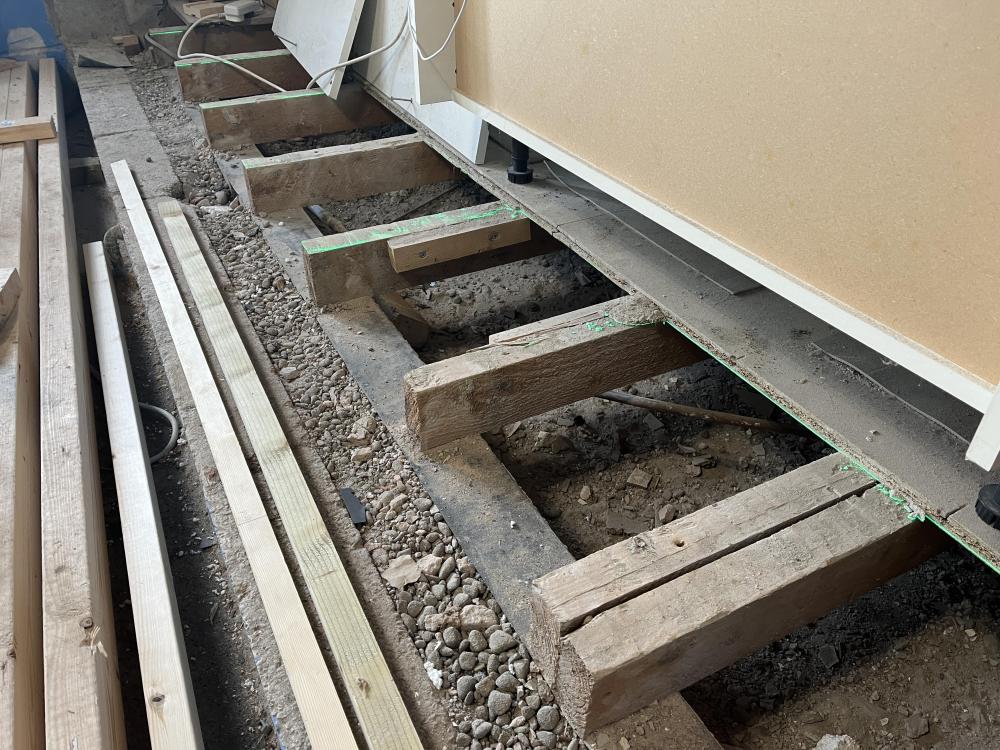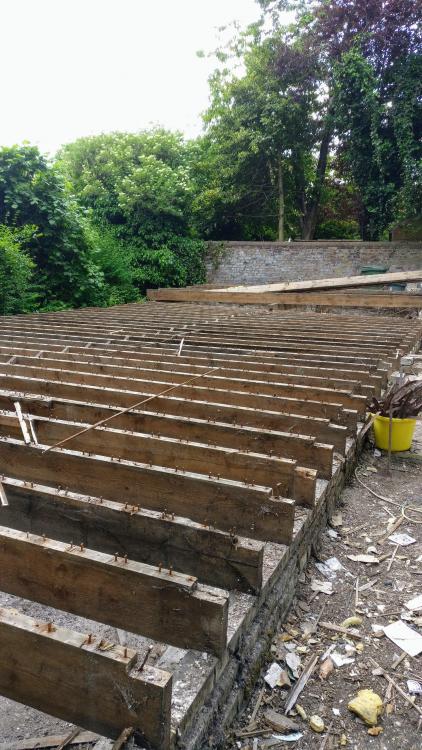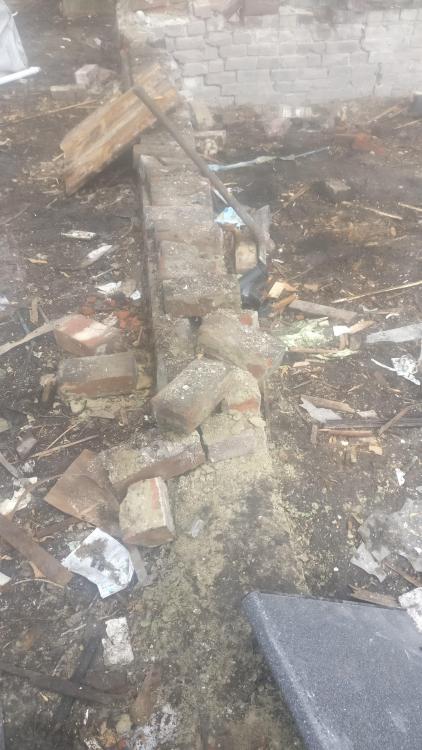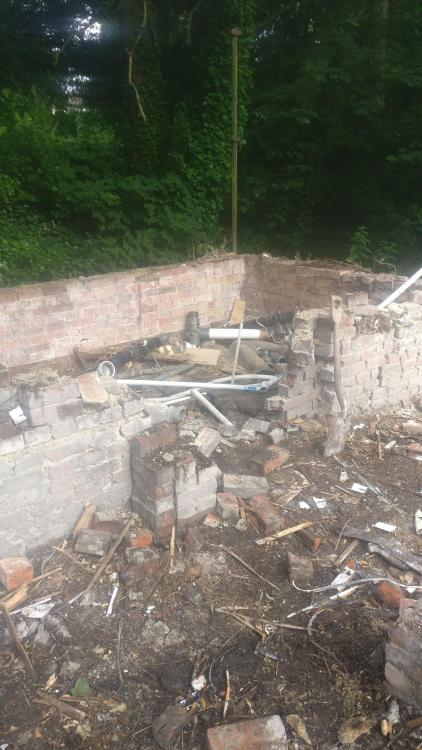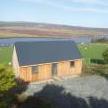Search the Community
Showing results for tags 'suspended floor'.
-
Hi we have a suspended floor. We used Omnie tor2 ufh floorboards with 6mm ply. The tiler used a crack mat and then we had 120cmx60cm porcelain tiles put down. The tiles keep cracking and the tiler said there is too much bounce in the floor. Any ideas how we can fix this bearing in mind we have ufh and although the ply had a pattern on showing where was safe to screw this has now been covered by the crack mat screed. Please help.
- 45 replies
-
- suspended floor
- ufh
-
(and 1 more)
Tagged with:
-
I’ve taken down a cavity wall that separated the kitchen & attached garage. Planning what to do with bringing new joists in garage to meet existing. Image below shows existing joists bearing onto what was the inner leaf. New joists will be coming from ledger plate off to the left. Originally thought I’d lap them ~100mm beyond the inner leaf. This is going to throw off chipboard ends landing on a joist part way through the room. would butt ending old and new be crazy? Bearing in mind that new would have 150mm bearing on the old outer (garage) leaf?
-
Hi, I’m going to be at the will of building control/planning as to whether or not I can keep a suspended timber ground floor in my Small Mission Hall in the Outer Hebrides. Whilst I wait for the outcome, I wanted to look into both options. It’s a small building internally (7.500m x 4.500m) so I’m not having a main boiler/central heating system/heat source pump etc. so water is out, I’ll be going for an electric system. I maybe looking at a solar feed system as well. A replacement concrete floor with electric underfloor heating seems a little more straightforward. Possibly better because of its thermal mass acting a bit like a storage heater? However, is it possible to do similar with a replacement suspended timber floor and still utilise relaying the existing floorboards? Would the result (if possible) be equal in terms of its thermal performance compared to a concrete floor? What are the pros/cons either way? Any advice or suggestions welcome…
- 5 replies
-
- timber floor
- suspended floor
- (and 3 more)
-
I was wondering what you think about insulating under a block and beam floor. Building control specifies approx 200mm ventilated gap under a suspended block and beam floor. I am quite unsure of why this is. Apart from expanding of clay floor underneath, I can't quite see a reason (with suspended timber, it would be air circulation, but for block and beam?) Would it be possible to fill the space underneath with insulation. For example perlite, or some other no moisture/rot sensitive materials, maybe eps in granulated form. What would be the problems that could arise from it? Anybody got some experience in doing this?
- 35 replies
-
Morning all, I'm after some advice as to whether it would be worth putting in a wet UFH system in our 1950s house that we are renovating, and if so, your thoughts about fitting LVT on top. The house has an old garden room extension at the back which we are opening up to make a 5.7x5.6m kitchen-dining area. There will be a vaulted roof over the old garden room which approximately half the kitchen-dining space will be under. We are planning to put some insulation into the old garden room as we don't think it has any at the moment. The house is built on suspended joists with approximately 600-700mm of void space under the original house and 250mm under the garden room. The joists are only 100mm deep, spaced 400-450mm apart. We were thinking of battening from underneath, adding 75mm insulation and finishing with 25mm UFH and dry screed mix. We ideally don't want to raise floor levels due to the lower ceiling height in the original part of the house. Finally, the house faces west and gets quite a lot of sunlight in the afternoon. We are also having 3 velux windows, bifold doors and a window looking out to the garden. 1) UFH vs two big radiators. Which would you get in this scenario for our project? We want the space to feel warm when we need it to but don't know what would be more effective. Would we lose lots of heat under the house? 2) If we were to get UFH then how would you finish the flooring to lay LVT? We were thinking of having 22mm chipboard, then 6mm ply, then LVT. Does that seem about right? 3) We'd like a herringbone LVT pattern but were recommended not to go for larger tiles due to the larger gapping that would occur in sunlight. Does anyone have experience of this? Thanks for your advice, I really appreciate it!
-
Hi, I’ve got a rear extension within 45sqm of floor area which will be new floor (insulated, concrete and liquid screed with ufh). The existing area at rear of house is 25sqm of timber suspended floor. I’ve looked at the void is 750mm deep. Is this too much to make up? So I just leave the existing as suspended and run ufh under floor boards onto insulation between joists then vent it through the new slab or fill it? The other advantage of doing that would be less chance of crack straight across what will be a new porcelain kitchen floor. Thanks in advance
-
I am nearly done with my entire demolition. We only got the little Brick Plinths wall left where the previous suspended Timber floor was sitting on : (This was the previous Timber Floor): The new Foundations go in the exact same spot as the old Brick wall (this is whats left of the now) : So my Problem is, I want to re use as many of the old bricks as possible , but a fair amount is just crushed or falling to pieces when you touch them. I am going to remove the bottom of the walls with a mini digger, but would like to avoid carrying/driving the old bricks that cant be reused out of the site. So my Plan was to keep them in the middle, underneath the new buildings Block and Beam floor . Maybe crush them to Gravel and fill the bottom of the Trenches as well. The only rule I am aware of atm for suspended Block and Beam floor is, that you need an airgap/clearance underneath of at least 150mm , better 225mm which is ventilated and clear of organic material. Is there any rules or practical reason not to do this . So my plan was next, to dig out the old wall and at the same time dig the trenches for the new build , ready for the piling contractor to put piles in and concrete the RC beam with the Piles in 1 go . Any suggestions?
- 7 replies
-
- block and beam
- suspended floor
-
(and 2 more)
Tagged with:
-
My bathroom floor is built up using 300mm JJI joists at 600 centres, over a 16ft span. 22mm T&G P5 chipboard on top. There is definitely a degree of deflection going on with this buildup. The bathroom itself is at one side of the span, taking up 1.6m, so coming to about a third of the span. Can I just stick tiles directly down onto this using an appropriate flexible adhesive? If not, would a layer of ply provide sufficient additional stiffness? I know that is the default procedure, but tbh I'd be surprised if e.g. an extra 12mm of ply would be able to change the degree of deflection by any measurable amount. Perhaps my intuition is way off on this. The other option is to give up on tiling, and just stick vinyl down, which would be OK, I guess. It would have the advantage of the bathroom floor being lower than the rest of the house, so less chance of water running out.


